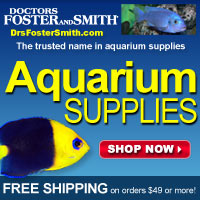Goldfish Grooming Series - Top View Ranchu
Goldfish grooming is a form of art which the owner learn how to provide an ultimate living condition and feeding schedules for the fish. As a result you will get a healthy, muscular (not fat) fish which will also live a longer life. In goldfish grooming, there is no major difference between method for grooming show fish and method for hobbyist. Simply hobbyist should feed less than what show-goers do. As a result, hobbyist's fish will produce less waste which leads to lesser water change. In this guide, we will train you how to groom top view ranchu properly. For top view ranchu, our goal is to have a beautiful adult fish with large peduncle and nice square head. Since the scope of this article is on grooming, we will start with 2” baby fish; at the stage when the fish starts eating pellet food, Black baby ranchu.
Before talking about grooming, it is recommend to study ranchu terminologies.
- Black Baby Ranchu (BBR): A baby fish is called BBR when it starts eating bloodworm or pellet until it attain adult color. Kuroko is a Japanese term for BBR.
- Color Baby Ranchu (CBR): Once a baby fish is getting its adult color, the fish is called color baby ranchu.
- Tosai: A fish born in current year is called Tosai.
- Nisai: A fish born in last year.
- Oya: An Oya fish is an adult fish which is already passing Nisai stage(3 years and above).
At the stage of of BBR or CBR; if the fish has less than 4” length (from mouth to tip of tail) then you should kept them at 4” of water dept. Additionally we prefer to raise them in 4’x4’ tub/tank. It will encourage them to swim horizontally in the tub. Horizontal swimming will promote the development of strong peduncle.
Feeding is also very important to produce a strong ranchu (Please do not confuse it with fat ranchu). At Tosai stage, it is necessary to feed both Frozen Bloodworm (FBW) and pellet food. FBW will provide a lot of protein for head growth (wen) while pellet will give necessary nutrient for body growth. It is recommend to feed every 3 hours from dawn to dust. I am giving them bloodworm for the first and last meal of the day. In that way, I can check their situation early in the morning before leaving to work and after coming back from work. I use automatic feeder to accomplish the feeding task while I am at work.
Water change is very crucial for baby fish. Water change is directly proportional to body growth and reversely proportional to head growth. If you do more frequent water change, you will encourage the body growth. On the other hand, less water change will help the head growth. How does it theory work? Once you do the water change, the fish will swim actively in the first few days. Active swimming will exercise the body muscle and get a body growth. Starting from the third day after water change, water get dirty and fish doesn’t swim much anymore. Most of the nutrient will gather at the wen at this time. As an owner, you have to adjust when to do water change base on your needs; for body growth on your fish, do more water change. Or slow down the frequency for head growth. It is very import to build all the necessary foundation for baby fish to achieve beautiful big fish. It is recommended by one of my mentor that you shouldn’t miss a single meal or single water change (if possible) at this stage. The goal here is to obtain at least 4” body length within 12 months after born (6” for show fish). When the fish reaches 4” in body length you can adjust the water depth to 5” by adding one more inch. Once the fish grow, you can keep adding inch by inch until 8” of depth. 8” depth is the maximum depth for any kind of Top view ranchu.
After the fish reaches one year old or Nisai status, it is recommend to give more living space. Ultimate suggestion is 6’x5’ tub with 8” deep of water. For feeding, I will refer to John Parker’s feeding method. John recommends to weight your fish every month and feed 2% of the body weight every day. You should feed several times a day and the amount of all those foods should equal to 2% of fish body weight. You should continue with your water change base on your requirement. It is the best to study your water and know when to do water change. For adult goldfish, I prefer to hibernate them during winter time. It will encourage them to breed or give you a break from grooming.






